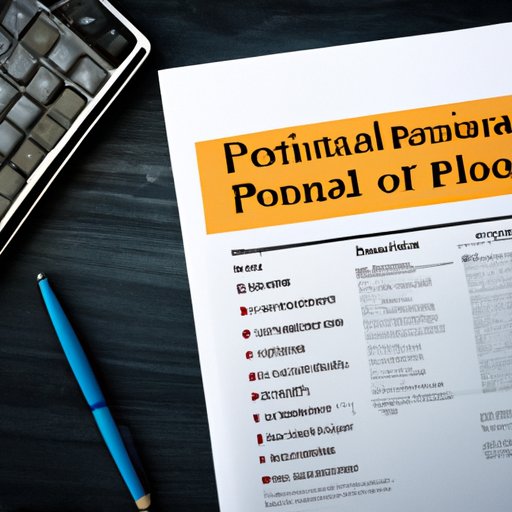Introduction
Pro forma financial statements are documents that project expected future financial performance. They are used to forecast revenue, expenses, and cash flow for a given period of time. Businesses use these statements to plan for short-term and long-term goals and assess the financial health of their organization.

Purpose of Pro Forma Financial Statements
Pro forma financial statements are used to help businesses make informed decisions about their finances. By creating accurate estimates of future revenue and expenses, businesses can plan for both short-term and long-term goals. Additionally, pro forma financial statements can be used to create cash flow projections, which can help businesses identify potential sources of funding and prepare for unexpected expenses.
Steps to Prepare Pro Forma Financial Statements
Creating accurate pro forma financial statements requires careful planning and research. The following steps can help you create reliable pro forma financial statements:
Gather Relevant Data
The first step in creating pro forma financial statements is to gather relevant data about your business. This includes financial information such as income statements, balance sheets, and cash flow statements. You should also collect data about the industry you operate in, such as market trends, competitor performance, and economic conditions.
Calculate Projected Revenues and Expenses
Once you have gathered the necessary data, you can begin to calculate projected revenues and expenses. Consider factors such as seasonality, inflation, and changes in consumer demand when estimating future revenue and expenses. Additionally, you should take into account any one-time events or investments that may affect your business’s financial performance.
Monitor and Update Pro Forma Financial Statements
It is important to regularly monitor and update your pro forma financial statements as your business evolves. As your business grows, you will need to adjust your projections to reflect changing market conditions. Additionally, you should review your pro forma financial statements at least once a year to ensure they remain accurate.

How to Project Future Cash Flows
In addition to calculating projected revenues and expenses, pro forma financial statements can also be used to project future cash flows. To do this, you must first identify the sources of revenue for your business. This could include sales, investments, or loans. Once you have identified the sources of revenue, you can estimate the cost of goods sold, operating expenses, taxes, and other costs associated with generating revenue.
Commonly Used Pro Forma Financial Statements
Pro forma financial statements typically include a balance sheet, income statement, and cash flow statement. The balance sheet lists assets, liabilities, and equity. The income statement shows revenues and expenses over a given period of time. The cash flow statement tracks the movement of cash in and out of a business. These documents provide a snapshot of a business’s current financial situation and can be used to make informed decisions about the future.

Role of Pro Forma Financial Statements in Business Planning
Pro forma financial statements are an essential tool for business planning. They can be used to assess the financial health of a business, facilitate financing decisions, and evaluate investment opportunities. By accurately estimating future revenues and expenses, businesses can make informed decisions about their finances and plan for future growth.
Conclusion
Pro forma financial statements are an important tool for business planning. They can help businesses accurately estimate future revenues and expenses, identify potential sources of funding, and assess the financial health of their organization. It is important to regularly monitor and update your pro forma financial statements to ensure they remain accurate. By creating accurate pro forma financial statements, businesses can make informed decisions about their finances and plan for future growth.
(Note: Is this article not meeting your expectations? Do you have knowledge or insights to share? Unlock new opportunities and expand your reach by joining our authors team. Click Registration to join us and share your expertise with our readers.)
